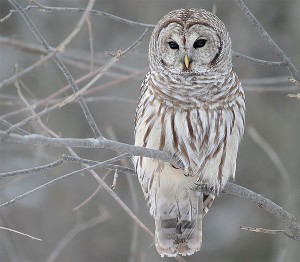Barred Owls likely are here to stay
Barred Owls likely are here to stay — January 19, 2016By Pam Otto
St. Charles Park District
Who doesn’t love a nice surprise? A batch of homemade peppermint bark, fragrant and tasty, pops up on your desk. A five-dollar bill, wet but still perfectly good, wondrously appears inside the washing machine.
A barred owl, uncommon in our area, shows up in a tree at Delnor Woods Park in St. Charles.
That third, spotted by Bob and Kathy Andrini during their bird monitoring trip on Dec. 22, 2015 … well, that shows just how well barred owls are doing in our area.
Historically, Strix varia was a bird of the forests that predominated across eastern North America. The birds preferred unfragmented forest habitat, ideally with some water—a pond, a stream, and a swamp. Common in the forested regions of southern Illinois, the species has been considered rare here in Kane County. But that may be changing.
Although somewhat sedentary by nature—they are nonmigratory and often spend their entire lives within a 6-mile radius—barred owls nonetheless seem to be steadily advancing their local range.
I remember hearing my first barred owls in our area back about 10 or 12 years ago at Johnson’s Mound and Blackberry Maples Forest Preserves, both of which are in Elburn; I also recall hearing one at Bliss Woods in Sugar Grove. In 2009 a barred owl was noted during the Christmas Bird Count at Fermilab in Batavia. And now the Andrinis have reported one in St. Charles.
Barred owls are stocky birds 18 to 20 inches in length, with a 42-inch wingspan. Unlike great horned owls, which have two protruding feather tufts or “horns” on their heads, the outline of the barred owl’s head is rounded and smooth.
A few factors may be working in the barred owls’ favor.
One, they aren’t fussy eaters. Barred owl diets can include the usual rodent prey, but also rabbits, birds, amphibians, reptiles and invertebrates. In addition, these owls are known to hunt fish and even wade in the shallows chasing crayfish.
Two, while they do have a preference for woodlands with old growth trees, barred owls are not particular about species. In southern Illinois I’ve seen them perched on the boughs of cypress and tupelo; up here I’ve seen them in silver maples and basswoods. Delnor Woods’ woods are primarily oak-hickory, but with a healthy dose of other trees, including conifers, sprinkled throughout.
Three, barred owls face few threats. Sure, there are the risks that come along with life near humans—namely road mortality and accidental poisoning. But as far as natural predators, there aren’t many. Great horned owls will prey on both juvenile and adult barreds, while raccoons will feed on eggs and nestlings.
I’m pretty certain that the barred owls are here to stay. What I’d like to know though is who else is seeing—or hearing—them, and where.
Unlike the great horneds, which rarely vocalize in the daytime, barred owls can whoop it up at almost any time of day. Their call is distinctive, variously described as “hoot-hoot-wahoot, hoot-hoot wahoooo,” or, my favorite, “Who cooks for you? Who cooks for you-allll.”?
How about it? Does the owl in the picture look familiar to you? Does the call seem like something you have heard in our area?
If so, I’d love to hear about it, and can let others know in next week’s column, where we will continue our look at area owls.
Pam Otto is the manager of nature programs and interpretive services at the Hickory Knolls Discovery Center, a facility of the St. Charles Park District. She can be reached at 630-513-4346 or potto@stcparks.org.
-Barred Owls likely are here to stay-




